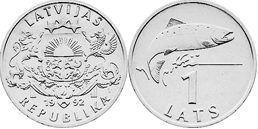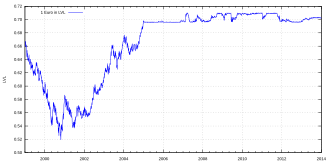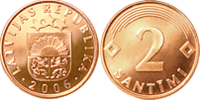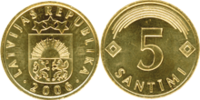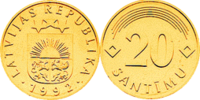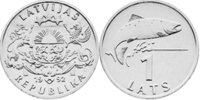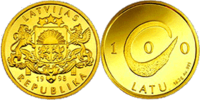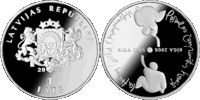Lats
| Lats | |
|---|---|
| Country: |
|
| Subdivision: | 100 santīmu |
| ISO 4217 code : | LVL |
| Abbreviation: | Ls |
|
Exchange rate : (fixed) |
1 EUR = 0.702804 LVL |
The Lats (plural: Lati, genitive plural: Latu (after numerals that are not inflected - desmit [10], simt [100], tūkstotis [1000] - is the Gen. Pl.), 1 Lats = 100 Santīmu) was from 1922 to June 17, 1940 and from October 1993 to December 31, 2013 the currency of Latvia . This makes it the predecessor of the Latvian euro coins .
history
The lats was introduced as a gold currency in 1922. The Latvian ruble ( Latvijas rublis , paper currency) previously served as the transition currency from the Russian ruble , which was then exchanged at a ratio of 50 Latvian rubles to 1 lats. There were notes of 5 lati, 10 and 20 latu, silver coins of 1 lati, 2 and 5 lati as well as copper and nickel coins. 1 Lats corresponded to a value of 0.81 gold marks in 1928 (Reichsmark in gold currency).
In the course of the occupation by the Soviet Union in the course of 1940, the lats was replaced by the Soviet ruble , this in the course of the occupation by National Socialist Germany by the Reichsmark, and this again by the Soviet ruble after the reoccupation by the Soviets.
After the independence of the Republic of Latvia was fully restored in August 1991, the Soviet ruble was initially renamed from the Latvian ruble ( Latvijas rublis , popularly called Repšes rublis , repši , repsīši or repšiki ) in the name of the then Latvian Finance Minister Einārs Repše on May 7, 1992 Course of 1: 1 replaced. The Latvian National Bank Latvijas Banka took the second step in October 1993: the exchange into Lat at the rate of 200 Latvian rubles to 1 Lat. This meant that Latvia had at times the most valuable currency unit in Europe. Einārs Repše confirmed a corresponding anecdote in 2003 about the origin of the exchange ratio: The proportion was chosen so that one could buy something useful for 1 Santīms, and a matchbox was then traded for 2 Latvian rubles. The stability of the currency has since been ensured by backing it with foreign currency and gold reserves as well as investments in a number of different foreign currencies.
On January 1, 2014, the lats was replaced by the euro as the national currency. On July 9, 2013, the finance ministers of the EU member states approved the accession of Latvia as the 18th euro country; their heads of state or government already did so at their summit at the end of June 2013. The exchange rate was 0.702804 lats per euro or 1 LVL = 1.422872 EUR fixed.
Exchange rate mechanism II
Latvia joined the EU on May 1, 2004 . Since January 1, 2005, in preparation for joining the euro , the lats has been pegged to the euro via a currency board with a low fluctuating exchange rate (maximum 1%). In 2007, however, it deviated more than 1% from the guideline value of LVL 0.696 / EUR. Previously, the lats was tied to the Special Drawing Rights of the International Monetary Fund (IMF), a currency basket that is mainly influenced by the dollar rate, and could therefore fluctuate slightly against the euro. On April 29, 2005, Malta and Cyprus joined the Exchange Rate Mechanism II .
Cash
Circulation coins were available in denominations of 1 lats and 2 lati as well as 1 santīms, 2, 5 santīmi, 10, 20 and 50 santīmu, banknotes of 5 lati, 10, 20, 50, 100 and 500 latu. The 500 Latu note was the banknote in general circulation with the second highest real value in Europe after the 1000 Swiss Franc note.
Course coins
Special coins
| image | motive | Issue date | Edition |
|---|---|---|---|

|
stork | 2001 | 250,000 |
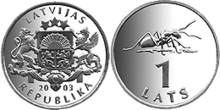
|
ant | 2003 | 250,000 |
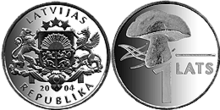
|
mushroom | 2004 | 500,000 |
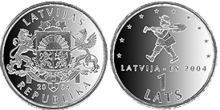
|
Sprīdītis | 2004 | 500,000 |
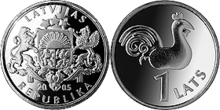
|
Weathercock of the Petrikirche |
May 25, 2005 | 500,000 |

|
Squiggles | December 14, 2005 | 500,000 |

|
Johanni wreath made of oak leaves |
June 15, 2006 | 1,000,000 |
(For 16 more 1-Lats commemorative coins, see Latvian Wikipedia )
- other special coins
1 Lats - Ice Hockey World Championship 2006 (2005)
Banknotes
The printing of the first series began in 1992. Small changes to the security features in subsequent years should ensure the security of the banknotes. The last series (20 Latu) was printed in 2009. All banknotes were 65 × 130 mm in size; the aspect ratio 1: 2 thus corresponded to the proportions of the flag of the Republic of Latvia .
| Note value | colour | front | back |
|---|---|---|---|
| 5 lati | green |
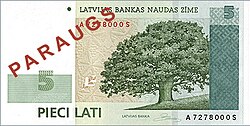 Oak Oak
|
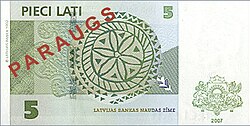 carved sun ornament carved sun ornament
|
| 10 latu | violet |
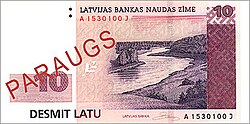 Daugava Daugava
|
 traditional Latvian fibula traditional Latvian fibula
|
| 20 latu | brown |
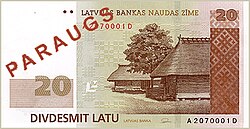 traditional Latvian farm traditional Latvian farm
|
 traditional Latvian weave ornaments traditional Latvian weave ornaments
|
| 50 latu | blue |
 Hanse cog Hanse cog
|
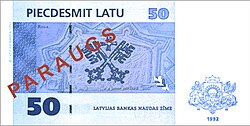 City coat of arms and map of Riga City coat of arms and map of Riga
|
| 100 latu | red |
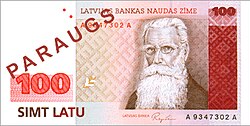 Krišjānis barons Krišjānis barons
|
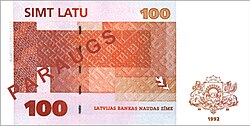 Fragments of the Lielvārdes josta Fragments of the Lielvārdes josta
|
| 500 latu | golden |
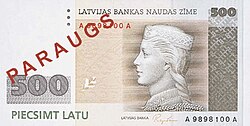 Latvian peasant girl Latvian peasant girl
|
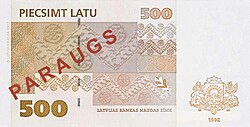 Ornaments of a bronze hat Ornaments of a bronze hat
|
Individual evidence
- ↑ Māris Gailis : Varas TEHNOLOGIJA. Jumava, Riga 1997, p. 65.
- ↑ Patstāvīga naudas sistēma Latvijā sākās ar Latvijas rubli , Interview (2007) with Einārs Repše on bank.lv, accessed on May 29, 2020.
- ↑ Lato Lapsa, Kristīne Jančevska: Mūsu Vēsture 1985-2005 , Volume 1, 2007, ISBN 978-9984-34-297-9 , p. 421.
- ↑ EU finance ministers approve admission: Latvia gets the euro. on: tagesschau.de , July 9, 2013, accessed on July 9, 2013.
- ↑ EU summit approves Latvia's entry into the euro. In: The Standard. June 28, 2013. Retrieved June 29, 2013.
- ↑ Par 1 lata monētas ar Pētergaiļa attēlu laišanu apgrozībā on bank.lv, accessed on May 29, 2020.
- ↑ Par 1 lata monētas ar kliņģera attēlu laišanu apgrozībā on bank.lv, accessed on May 29, 2020.
- ↑ Par 1 lata monētas ar Jāņu vainaga attēlu laišanu apgrozībā on bank.lv, accessed on May 29, 2020.
- ↑ Latvijas Bankas papīra naudas zīmes (banknotes) on bank.lv, accessed on May 29, 2020.
